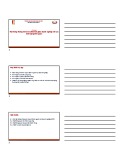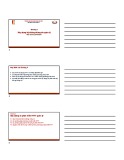Step II. Create Publication
1.Specify the Publisher Properties and select Transactional Databases at this artical
Click this bar to view the small image.
Figure 15 staring the publisher properties
Click this bar to view the small image.
Figure 16.specifing the publication databases.
For more information about Transactional and merge,pls see "Troubleshooting Oracle Publishers" in SQL Server Books Online
2. After you have connected to the instance, start the New Publication Wizard.
A.Expand the server node.
B.Expand the Replication folder.
C.Right-click the Local Publications folder and then click New Publication
The rest of this section covers the steps in the wizard in more detail
Click this bar to view the small image.
Figure 17. Starting the New Publication Wizard
3. The New Publication Wizard introduction page is displayed.then click Next
Click this bar to view the small image.
Figure 18. New Publication Wizard introduction page
4. Choose the database U wanna to publish. Select the publication type and click Next
Click this bar to view the small image.
Figure 19.specifing the publication database
5. On the Publication Type page, you select the type of replication to use. Select Snapshot publication if you want all the published data to be copied every time replication executes. Select Transactional publication if you want to start by copying all the published data and then continuously stream subsequent data changes to SQL Server in near real time.
Note: For more information, see the topic "Transactional Replication Publishers" in SQL Server Books Online.
Select the publication type and click Next.
The rest of this article assumes that you selected Transactional publication.
Click this bar to view the small image.
Figure 20. Specifying the publication type
6.On the Articles page, select the tables that you want to publish from the Objects to publish list. If there are columns of data that you do not want to replicate, you can remove the columns from the published table by clearing the check box next to each column.
Note: A table can appear among the Objects to publish only if SELECT permissions for the table have been granted directly to the replication administrative user.
Click this bar to view the small image.
Figure 21. Selecting the tables to replicate
Note: If a column contains an MSSQL data type that might result in data loss when it is converted to a SQL Server data type, a yellow warning sign is displayed next to the column. In the following illustration, the HIREDATE column contains date data that might result in data loss. You can optionally select an alternative to the default SQL Server data type. First, access the properties for the published table.
A. Select the table in the Objects to publish list and then click Article Properties.
B. Click Set the Properties of Highlighted Table Article.
In the next step, you can select an alternative data type.
Click this bar to view the small image.
Figure 22. Accessing properties of published tables
Click this bar to view the small image.
Figure 23. Changing article types for Subscriber article
7.You can optionally specify that you require only a subset of the data to be published. To specify a filter for a table, you specify a WHERE clause using SQL- compliant syntax.
A. On the Filter Table Rows page, click Add.
B. In the Add Filter dialog box, select a table to filter from the list.
C. In the Filter statement text area, type a WHERE clause.
D. Click OK.
E. Click Next.
Click this bar to view the small image.
Figure 24. Filtering data
8.On the Snapshot Agent page, select whether you want to start creating snapshot data files immediately after the wizard finishes, or at a later time.
A. Select the option to create a snapshot immediately.
B. Click Next.
Click this bar to view the small image.
Figure 25. Scheduling the snapshot
9.The Snapshot Agent and Log Reader Agent pull data from the Publisher. On the Agent Security page, you specify the Windows user under which each agent should run.
Each user must be a member of the sysadmin fixed server role on the SQL Server Distributor.
Additionally, the Windows user under which the Snapshot Agent runs must have
write permissions on the snapshot folder. By default, the snapshot folder is located
at
A.Click Security Settings to specify settings for each agent. If you want to specify the same settings for the Log Reader Agent and Snapshot Agent, specify the Snaphot Agent settings first and then select Use the security settings from the Snapshot Agent.
B. Click Next.
10.On the Wizard Actions page, you specify when the publication will be created, and whether the publication configuration is saved in a script. We recommend that you select the check box for scripting so that you will have a copy of the replication configuration for future reference.
A. Select both check boxes.
B. Click Next.
Click this bar to view the small image.
Figure 27. Scripting and creating the publication
11. Create Publication Script File.click Next
Click this bar to view the small image.
Figure 28. CreatePublication sql script
12.On the Complete the Wizard page, you can verify that all options are correct, and provide a name for the publication.
A. Type a name for the publication.
B. Verify options, and click Back to change your selections if necessary.
C. Click Finish.
Click this bar to view the small image.
Figure 29. Completing the New Publication Wizard
13.The New Publication Wizard now saves the configuration information that you have entered and creates the publication. Click Close after the steps are finished.
Click this bar to view the small image.
Figure 30. Creating the publication
The publication that you created appears under the Replication folder in SQL Server Management Studio.
Click this bar to view the small image.
Figure 31. Viewing the new publication





![Tài liệu học tập Hệ thống thông tin quản lý [mới nhất, đầy đủ]](https://cdn.tailieu.vn/images/document/thumbnail/2025/20250716/vijiraiya/135x160/512_tai-lieu-hoc-tap-he-thong-thong-tin-quan-ly.jpg)













![Hệ thống quản lý cửa hàng bán thức ăn nhanh: Bài tập lớn [chuẩn nhất]](https://cdn.tailieu.vn/images/document/thumbnail/2025/20251112/nguyenhuan6724@gmail.com/135x160/54361762936114.jpg)
![Bộ câu hỏi trắc nghiệm Nhập môn Công nghệ phần mềm [mới nhất]](https://cdn.tailieu.vn/images/document/thumbnail/2025/20251111/nguyenhoangkhang07207@gmail.com/135x160/20831762916734.jpg)





